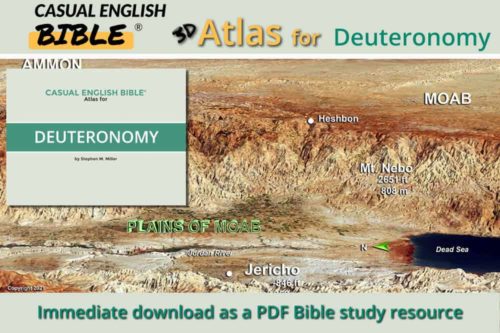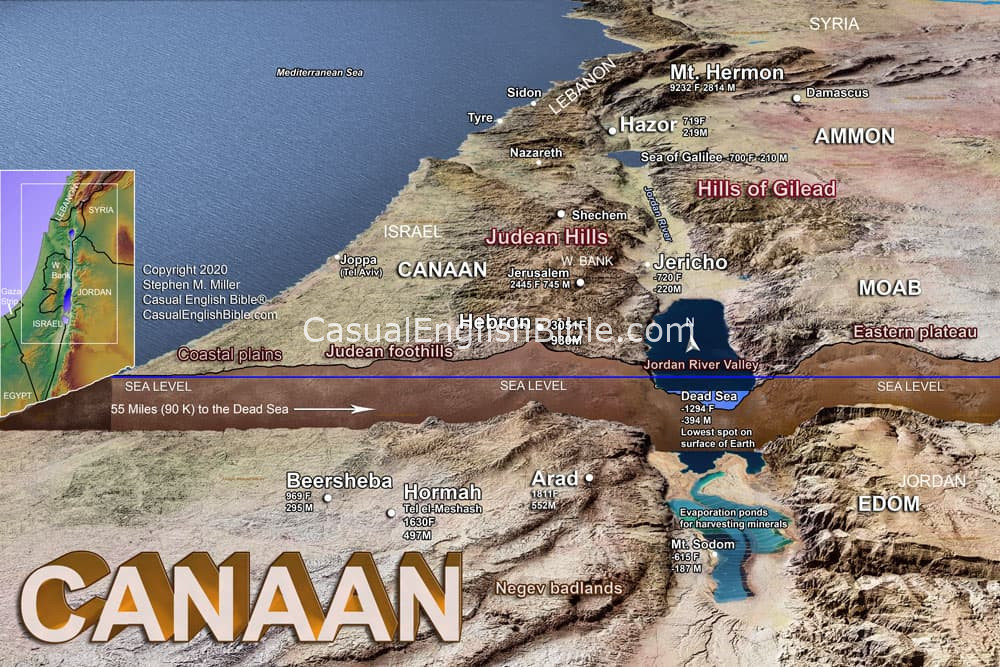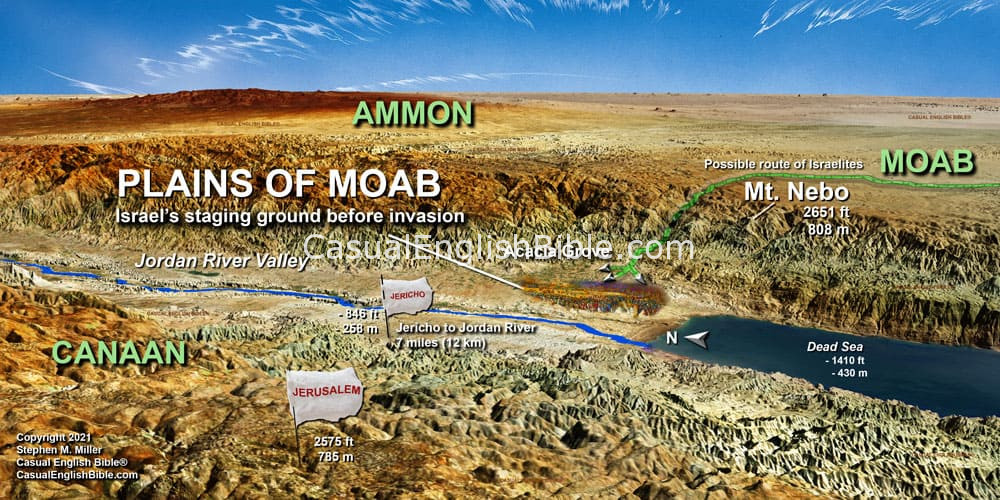Deuteronomy 34
Moses dies
Moses climbs Mount Nebo
1Moses left the grassy plains of Moab. He climbed Mount Nebo to the Pisgah summit, across the Jordan River from Jericho. The LORD showed him the land below. [1] He saw Gilead as far as Dan’s tribe. [2] 2He saw Naphtali’s land, too. He could see Ephraim and Manasseh. He saw the tribal land of Judah, all the way to the Mediterranean Sea. 3He saw the Negev desert in the south along with the valley of Jericho, a city people called the City of Palms. [3] He could see all the way to Zoar.3He saw the Negev desert in the south along with the valley of Jericho, a city people called the City of Palms. He could see all the way to Zoar. 4The LORD told Moses, “This is the land I promised Abraham, Isaac, and Jacob. I told each of them, ‘I’ll give this land to your descendants.’ Well, you’ve seen this land with your own eyes. But I won’t let you go there.”
Moses, dead and buried
5Moses, the LORD’s devoted worker, died there in the land of Moab, as the LORD said. 6Moses was buried [4] in Moab, in a valley next to Beth-Peor. [5] Still today, no one knows exactly where. 7Moses died at age 120, still strong and with good eyesight. 8Israel’s people mourned Moses for 30 days, there in the plains of Moab.Joshua takes over
9Before Moses died, he placed his hands [6] on Joshua, the son of Nun. Wisdom filled Joshua like a breath of fresh air, delivering a spirit [7] of insight. The people of Israel accepted him as their leader just as the LORD told Moses they should do. 10Israel has never seen another prophet like Moses. The LORD talked face to face with Moses. 11And the LORD sent him to Egypt to do incredible miracles to give Pharaoh and his people signs and warnings to set us free. 12Moses had incredible and even frightening power. And he used it to do amazing things, which the people of Israel saw with their own eyes.Footnotes
It’s unclear what Moses saw. The writer says Moses saw the northern boundary of the tribal territory, which is about 100 miles (160 km) from Mount Nebo. And he saw the Negev desert and Zoar, a city that scholars typically say was located around the southern part of the Dead Sea. Genesis says that’s where Lot and his daughters went when they escaped the fiery destruction of the twin cities of Sodom and Gomorrah (Genesis 19:23). Zoar and the Negev were over 70 miles (113 km) south of Moses. Mount Nebo has the highest summit on the plateau, at 2,300 feet elevation, or 710 meters. That’s an especially good vantage point to view what is now Jordan River Valley areas of Israel and Palestinian territories. That’s because the Dead Sea is about 1,400 feet below sea level, or 430 meters. That puts Moses more than a kilometer above the Jordan River Valley, about three-fourths of a mile. But it might seem a stretch to think of Moses literally seeing 100 miles from a mountain just half a mile high. Some scholars say Moses saw the land in general—not in crisp detail—as far as the angle on the horizon permitted. Some others say Moses may have seen more. Perhaps he saw the land in a vision or in some other way. Apostle Paul talked about a man (possibly himself) who was “somehow transported all the way up to the third heaven. I don’t know if this was an out-of-body experience. Only God knows” (2 Corinthians 12:2).
Dan initially settled along the Mediterranean seacoast, too close for comfort to the powerful Philistines. Dan later moved from the seacoast to the foot of Mount Hermon, beside the tribe of Naphtali. That was on Israel’s northern border, far from the menacing Philistines.
Jericho is an oasis town on the border of a rocky wasteland in the Judean hills. Jericho’s palm trees, farms, and orchards are fed water by the spring of Ein es-Sultan, which delivers about 1,000 gallons (3,800 liters) of water a minute. At 846 feet (258 m) below sea level, Jericho is the lowest city in the world.
Many Bible versions say “He [God] buried Moses.” The Hebrew language doesn’t say that. There’s no “he” in the collection of words. There’s just qabar “buried” and moab. We can only imagine or presume how the burial took place and who did the digging. Many scholars say the context—with a story that stars only Moses and God—suggests that God buried him. And there’s some backup support in the reported fact that no one seemed to know where the grave was. An unmarked grave would have kept people from creating a shrine over the site. Also, the statement that “Still today” no one knew where the grave was implies that at least this part of the story was written long after Moses. Deuteronomy 34:10 makes that even more obvious.
Beth-Peor was a city near Mount Nebo in the Pisgah mountains. The valley mentioned may have been what is described elsewhere as the “plains of Moab,” on the east side of the Jordan River, across from Jericho.
Moses seemed to be spiritually transferring his responsibility to Joshua, along with the kind of authority and wisdom that God occasionally gave to others for the work they needed to do (Exodus 28:3; 35:31).
The word for “spirit” in Hebrew is ruah. Like the Greek word used in the New Testament, pneuma, it can mean breath, wind, or spirit. We use this Greek word when we talk about air-powered tools: pneumatic. Wind is often associated with God. When the prophet Ezekiel had a vision about a valley full of human skeletons coming back to life, it was divine wind that breathed life back into the bodies once the muscles and flesh had covered the bones (Ezekiel 37:9-10). Christians as well as many Jews in Jesus’ day taught that the spirit or soul lives on after the body dies. Some Bible experts say that Luke 5:35-43 reported that a girl’s spirit returned to her body at the command of Jesus. When that happened, her breath returned as well, and she came back to life.
Discussion Questions
- Sorry, there are currently no questions for this chapter.








